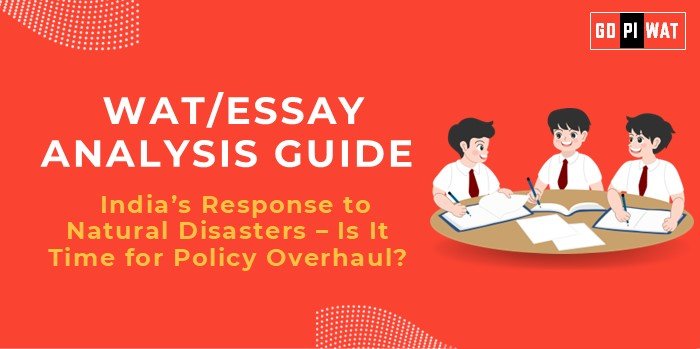📋 WAT/Essay Analysis Guide
🌍 India’s Response to Natural Disasters – Is It Time for Policy Overhaul?
🌐 Understanding the Topic
India’s vulnerability to natural disasters, their economic impact, and the interplay of policy and technology make this topic highly relevant for discussing governance and sustainability at B-schools.
📝 Effective Planning and Writing
- Time Allocation: Planning: 5 mins, Writing: 20 mins, Review: 5 mins.
- Structure:
- Introduction: 70 words.
- Body: 350-375 words.
- Conclusion: 60-70 words.
🎯 Introduction Techniques for Essays
- Contrast Approach: “While India’s cyclone mortality rates have dropped, floods and earthquakes expose the inadequacies in its disaster management policies.”
- Solution-Based Approach: “India’s growing disaster vulnerabilities necessitate an overhaul in policy frameworks to ensure effective response mechanisms.”
🏗 Structuring the Essay Body
📈 Achievements:
- NDMA’s role in reducing cyclone-related deaths.
- Significant funding allocations, such as the ₹1,60,153 crore SDRMF.
⚠️ Challenges:
- Infrastructure deficiencies and delayed response times.
- Community awareness gaps and low disaster education penetration.
- High economic losses from floods, earthquakes, and cyclones.
🔮 Future Outlook:
- Adoption of advanced forecasting technologies and early warning systems.
- Building resilient infrastructure in disaster-prone areas.
- Global partnerships and learning from international best practices.
🧩 Concluding Effectively
- Balanced Conclusion: “India’s disaster management framework reflects progress but requires robust policy revisions to address preparedness and resilience.”
- Comparative Conclusion: “Learning from Japan’s disaster resilience and Indonesia’s community-driven approach can shape India’s future disaster policies.”
🔍 Analyzing Successes and Shortcomings
🏆 Successes:
- Reduction in cyclone-related fatalities.
- Establishment of NDMA frameworks and allocated funds.
⚠️ Challenges:
- Inadequate early warning systems for floods and earthquakes.
- Funding utilization gaps and inefficient disaster response mechanisms.
🌏 Global Context:
- Adopting resilient infrastructure practices from Japan.
- Incorporating community-driven disaster response models like those in Indonesia.
📢 Recommendations for Sustainable Progress
- Enhance grassroots disaster education and community awareness.
- Build disaster-resilient infrastructure in vulnerable regions.
- Leverage advanced forecasting technologies and global partnerships.
✨ Sample Short Essays
Balanced Perspective:
“India’s disaster management policies have evolved significantly, reducing cyclone deaths. However, policy overhauls and better implementation are needed to address broader vulnerabilities.”
Solution-Oriented:
“India must shift focus to proactive disaster management by improving infrastructure, community involvement, and leveraging technology.”
Global Comparison:
“India can emulate Japan’s resilient infrastructure and Indonesia’s community initiatives to strengthen disaster management policies.”


